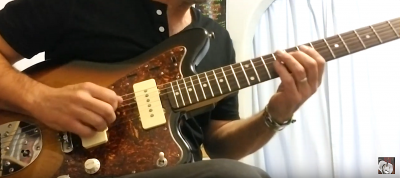Minor Blues Scales For Guitar |
|
|
|
|
|
| Sep 18 2013, 12:38 PM |
|
I really like this scale If I remember correctly, the #4 is a lydian note, so would it be possible to get some interesting sounds by soloing with the blues scale over lydian chords? As long as you'd play with confidence and land more or less on chord tones, I guess it'd work. but say in A lydian you have: A B C# D# E F# G# Where as A blues is: A C D D# E G So you see, you'd get a clash on the third and seventh. Without the minor seventh you'd have a bebop scale, I think, but with the minor seventh I'm not sure what you're getting. Then you must also remember that Lydian is a major sounding mode, so the minor third from the blues scale would probably clash on some chords. In a simple lydian chord progression: Amaj7, B, Amaj7, B... you'd have a few clashes. Here's a link to a nice article from Andrew Cockburn about modes and so on. Perhaps it offers a little insight: https://www.guitarmasterclass.net/guitar_fo...?showtopic=6023 Otherwise, get a lydian backing track and start playing. See if it sounds alright EDIT: Perhaps try a major blues as well: R 2 b3 3 5 6 A B C C# E F# This post has been edited by Caelumamittendum: Sep 18 2013, 12:44 PM |
|
|
||
|
|
|
|
| Sep 18 2013, 04:21 PM |
|
But I mean over a distinct lydian progression such as with a Cmaj7 chord to D, which gives you a feeling of all the scale degrees, I'd just think that playing some of the stuff over those chords would clash too much. I'll try it out a bit later. Try an F# minor blues scale over that prog. -------------------- - Ken Lasaine
https://soundcloud.com/klasaine2/foolin-the-clouds https://soundcloud.com/klasaine2/surfin-at-the-country-hop Soundcloud assorted ... https://soundcloud.com/klasaine3 New record ... http://www.cdbaby.com/cd/kenlasaine Solo Guitar ... https://www.youtube.com/playlist?list=PLXZh...5iIdO2tpgtj25Ke Stuff I'm on ... https://www.youtube.com/playlist?list=PLXZh...b-dhb-4B0KgRY-d |
|
|
||
|
|
|
|
| Sep 18 2013, 05:24 PM |
|
Try an F# minor blues scale over that prog. Yeah, that'd probably be better. I just thought the question was A minor blues over A lydian or similar. |
|
|
||
|
|
|
|
| Sep 18 2013, 06:33 PM |
|
Yeah, that'd probably be better. I just thought the question was A minor blues over A lydian or similar. Yeah, I really only consider something 'lydian' sounding if it's major (or sometimes dominant) sounding. -------------------- - Ken Lasaine
https://soundcloud.com/klasaine2/foolin-the-clouds https://soundcloud.com/klasaine2/surfin-at-the-country-hop Soundcloud assorted ... https://soundcloud.com/klasaine3 New record ... http://www.cdbaby.com/cd/kenlasaine Solo Guitar ... https://www.youtube.com/playlist?list=PLXZh...5iIdO2tpgtj25Ke Stuff I'm on ... https://www.youtube.com/playlist?list=PLXZh...b-dhb-4B0KgRY-d |
|
|
||
1 User(s) are reading this topic (1 Guests and 0 Anonymous Users)
0 Members:



























